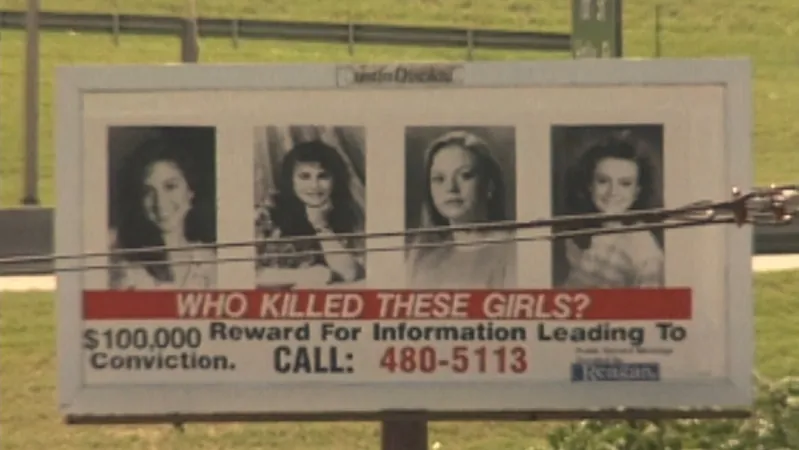
‘The Yogurt Shop Murders’: A Deep Dive into Austin’s Darkest Chapter
2025-08-03
Author: Ying
More Than 30 Years Later: Revisiting a Tragic Case
In a haunting re-examination more than three decades after the brutal murders of four teenage girls at a yogurt shop in Austin, HBO is set to air a documentary series titled *The Yogurt Shop Murders*. The 1991 case, often referred to as the event that shattered Austin’s innocence, continues to send ripples through the community as affected families still seek closure.
A City Haunted by Tragedy
The tragic deaths of Amy Ayers, sisters Jennifer and Sarah Harbison, and Eliza Thomas sent shockwaves throughout Austin. The community was gripped by fear and speculation as the investigation dragged on without resolution. Margaret Brown, the director, recalls the eerie atmosphere of the late '90s, where billboards with the girls' faces became staples across the city, sparking endless conversations and theories among friends and reporters alike.
Unveiling the Emotional Impact
Through a captivating blend of archival footage and heartfelt interviews, the series explores not only the multifaceted investigation that ensued but also the profound grief experienced by the victims’ families over the years. Brown emphasizes the importance of connecting emotionally with those impacted, stating that the storytelling needed to reflect the depth of that pain.
Balancing Investigation and Emotion
Brown faced the challenge of balancing an intricate narrative of the investigation with the emotional turmoil faced by the families. She approached her subjects with sensitivity, noting, "I wanted to listen and respond emotionally without judgment." The story, she felt, could not be simplified into mere true crime theatrics, especially when the families' suffering was palpable.
A Shared Journey of Healing
The documentary includes voices such as Claire Huey, a filmmaker profoundly impacted by the case, whose footage adds a personal glimpse into the chaos and despair it caused. Brown, who connected deeply with Claire’s experience, finds solace in the shared understanding of navigating through darkness.
Avoiding Conspiracy-Theory Pitfalls
Choosing to steer clear of sensationalist conspiracy theories, Brown reveals that her intention was to honor the humanity of those involved. "When you meet the families, it’s impossible to view this as just another crime story," she explains, highlighting the emotional toll of personal loss that permeates the narrative.
A Heart-Wrenching Moment—and a Beacon of Hope
One of the most poignant moments captured in the documentary revolves around a time capsule unearthing for Amy Ayers. Witnessing the community rally to support the Ayers family during this emotionally charged event was a reminder of the unity and care that still exists, showing that even amidst tragedy, there can be moments of collective healing.
Exploring the Nature of Human Grief
Rather than focusing solely on solving the case, Brown's priority lies in delving into the complex nature of grief and human experience. "This film is as much about understanding suffering as it is about the crime itself," she notes, reflecting on the three and a half years dedicated to bringing this story to light.
An Ongoing Journey
Even as the case remains unresolved, the documentary invites viewers to recognize the ongoing pain and resilience of those affected. Brown's exploration serves not just as a narrative about unsolved crime but as a profound discourse on loss and healing, reminding us that some stories, though they may never find closure, continue to shape the lives of many.



 Brasil (PT)
Brasil (PT)
 Canada (EN)
Canada (EN)
 Chile (ES)
Chile (ES)
 Česko (CS)
Česko (CS)
 대한민국 (KO)
대한민국 (KO)
 España (ES)
España (ES)
 France (FR)
France (FR)
 Hong Kong (EN)
Hong Kong (EN)
 Italia (IT)
Italia (IT)
 日本 (JA)
日本 (JA)
 Magyarország (HU)
Magyarország (HU)
 Norge (NO)
Norge (NO)
 Polska (PL)
Polska (PL)
 Schweiz (DE)
Schweiz (DE)
 Singapore (EN)
Singapore (EN)
 Sverige (SV)
Sverige (SV)
 Suomi (FI)
Suomi (FI)
 Türkiye (TR)
Türkiye (TR)
 الإمارات العربية المتحدة (AR)
الإمارات العربية المتحدة (AR)